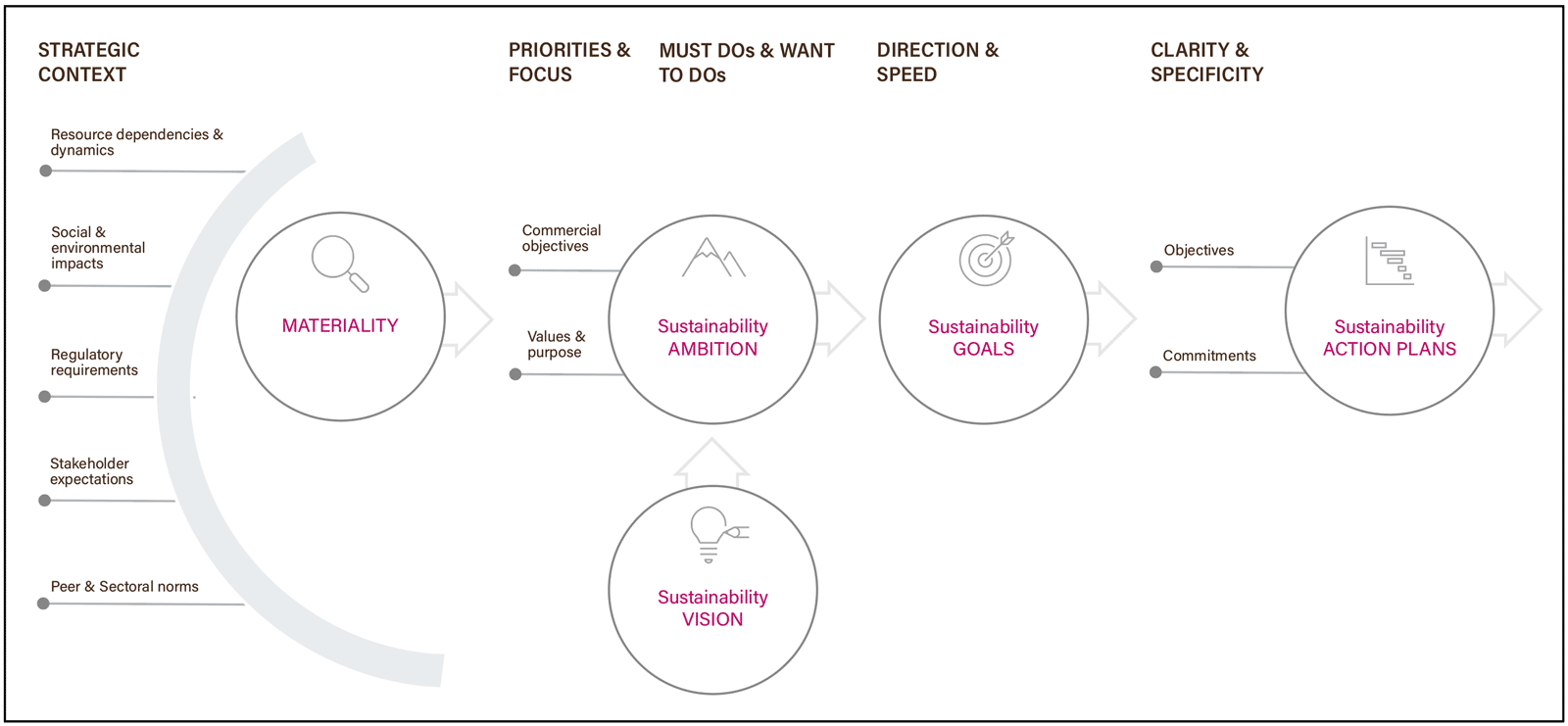A strong and clearly defined sustainability ambition shapes how a company aligns its purpose, strategy, and actions toward long-term value creation. It provides both a destination and a timeframe, describing what success in sustainability looks like and setting the pace for achieving it.

What is sustainability ambition?
Understanding and defining ambition is a crucial element of sustainability strategy and management. Sustainability ambition relates to areas and aspects where the company has a degree of choice to decide what, where and how it acts.
Simply, sustainability ambition is a description of where an organisation will focus its effort on sustainability, what it is seeking to achieve and how fast it is planning to achieve it. Therefore, understanding and defining ambition is a crucial element of both sustainability strategy and consequently, effective sustainability communications.
A strong and clearly defined sustainability ambition serves as a cornerstone for how an organisation shapes purpose, strategy, and operational activities in pursuit of long-term sustainable transformation and value creation. It should include clear descriptions of desired outcomes, the ‘destination’, together with a planned timeframe. A well-articulated sustainability ambition typically includes a vision for long-term direction of travel and intended outcomes. While it may be far in the future, the ambition should include and describe tangible objectives and outcomes while also setting the pace and milestones necessary for progress. This clarity not only guides strategic planning but also provides reference points for managing and disclosing progress and performance.

What are the core features of good sustainability ambition?
Developing and defining sustainability ambition encompasses several key critical dimensions.
Strategic Direction
A robust sustainability ambition integrates all material environmental, social, and governance (ESG) considerations into the organisation’s overarching vision and business model. A key aspect of understanding ambition is that it should be active rather than reactive. Rather than responding passively to regulatory requirements or external pressures, the company should proactively set targeted goals that reflect its unique context, competitive landscape, and long-term aspirations. This approach ensures sustainability is embedded in decision-making at every level, aligning leadership and departmental objectives with broader corporate priorities. It also supports a directed and active response that you have greater control over.
Scope and Focus
Setting a sustainability ambition requires a nuanced understanding of which aspects and issues are most material to the company’s success and its stakeholders’ expectations. Typically, this should be based upon a rigorous materiality assessment to identify priority issues (such as climate change adaptation & targets, data privacy, use of AI, resource efficiency, supply chain ethics, diversity and inclusion, or responsible governance). By focusing efforts on these core themes, the company can concentrate resources on initiatives that yield the greatest impact, while also remaining responsive to fundamental dependencies and vulnerabilities, emerging risks and opportunities. While a material focus should always provide the foundations, exploring and defining sustainability ambition should also include other aspects that help drive and meet the company’s wider commercial and values-based objectives.
Operational Foundation
Capturing and describing ambition provides ‘what’ the organisation wants to achieve, together with an indication of ‘how fast’. It also provides the crucial bridge for translating intentions into action. Best practice in sustainability management necessitates setting clear, measurable objectives that cascade through the organisation. This in turn, facilitates the development of long-term targets and key performance indicators (KPIs) which can help empower teams to innovate, and helps ensure the allocation of resources aligns with strategic priorities.
Cultural Alignment
The process of developing a clearly defined sustainability ambition can help to embed sustainable thinking into the fabric of organisational culture. This can help move sustainability from mere sets of policies or targets to a more powerful and widely understood narrative for sustainability – what matters for the company and its stakeholders, and what areas of action will be progressed. Used appropriately, this can provide the basis for stimulating everyday behaviours, decision-making, and leadership practices. It can help leaders champion sustainability as a driver of innovation, effective risk management, and long-term growth because ambition helps people take control of sustainability as a value creator rather than viewing it as either too overwhelming to grasp or as merely a compliance issue. Such a cultural shift strengthens internal engagement and nurtures a collective commitment.
Stakeholder Communication
Articulating a compelling sustainability ambition enables transparent and consistent communication with investors, partners, customers, and regulators. With a foundation in materiality, ambition provides both substance and a powerful narrative that can/should be unique to your organisation.
By openly sharing progress, challenges, and future ambitions, organisations build trust and credibility, differentiate themselves in the marketplace, and invite constructive dialogue with external stakeholders. This transparency also helps to mitigate reputational risks and assures stakeholders that the company’s actions are both authentic and effective.
Grounded in action
While developing clarity on future ambitions and communicating these clearly is both valuable and important, it should represent a step on the route to action. Communicating lofty intent in the absence of concrete plans, planned actions and explicit commitments is typically seen as greenwashing. Therefore, developing ambition should be seen as a step within wider sustainability strategy development and transformation planning processes
In conclusion
Ultimately, understanding and defining sustainability ambition is the essential core of best practice in sustainability strategy. It helps transform thinking about sustainability from a compliance issue into a source of strategic differentiation and resilience. It helps companies make informed and conscious choices about their impact, act with accountability, and create lasting value for both society and business.

 Why we should be reinforcing sustainable strategy in challenging times
Why we should be reinforcing sustainable strategy in challenging times